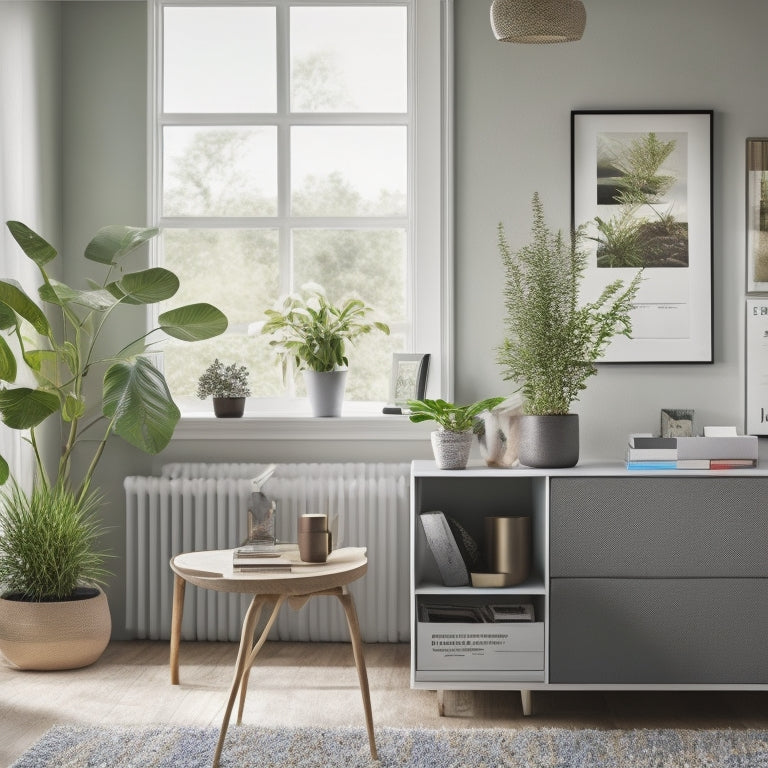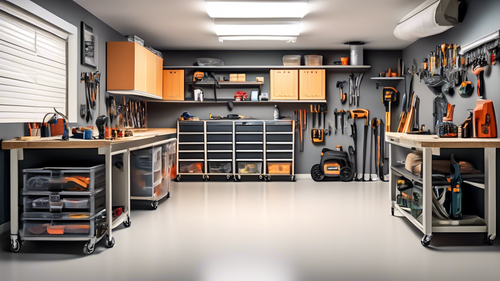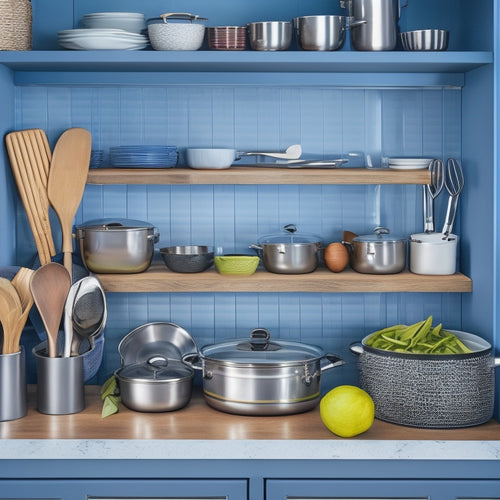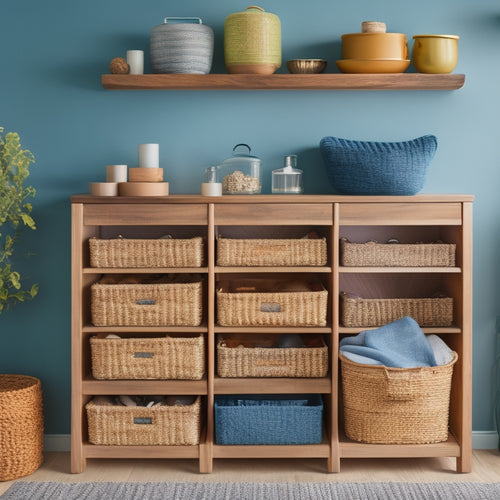
ADHD-Friendly Home Organization Made Simple
Share
You're about to change your living space into a haven of clarity and productivity, where your unique cognitive strengths shine and chaos takes a backseat. Start by embracing your ADHD chaos, focusing on systems that align with your strengths, and adopting playful organization methods through experimentation. Simplify your spaces by removing non-essential items, creating sensory-friendly zones, and designating specific spots for each item. Use visual cues like task lists and cue cards to aid in tracking tasks and routines. By implementing these strategies, you'll be well on your way to creating a peaceful environment that sparks joy and enhances your productivity - and that's just the beginning.
Key Takeaways
- Adopt playful organization methods through experimentation to create systems that align with your unique cognitive strengths.
- Focus on mindful decluttering techniques to simplify storage, reduce chaos, and enhance joy and productivity in your spaces.
- Implement visual reminders, such as daily task lists and reminder charts, to aid in tracking tasks and routines.
- Break tasks into manageable chunks and prioritize them based on importance and urgency to build routines with ease.
- Optimize furniture with multi-purpose storage solutions and use labeled containers for easy access and organization to maximize storage for clarity.
Embracing the Chaos of ADHD
Embracing the chaos that often accompanies ADHD can be a liberating experience, allowing you to focus on what really matters - creating systems that work with your unique brain, rather than against it.
By practicing mindful acceptance, you can let go of the need for perfection and instead, focus on finding solutions that accommodate your strengths and weaknesses.
With the help of mindful decluttering techniques digital minimalism strategies, you can simplify your storage and create functional systems that bring a sense of calmness.
This means adopting a playful organization approach, where you experiment with different methods until you find what works best for you.
Don't be afraid to try new things, and don't worry if your systems aren't "Pinterest-perfect."
The goal is to create a space that sparks joy and productivity, not one that adds to your stress and anxiety.
Simplifying Spaces for Focus
As you begin to simplify your spaces, consider this: every item you own is competing for your attention, making it harder to focus on what's truly important.
To combat this, practice mindful decluttering by removing items that don't serve a purpose or bring you joy. This will help create sensory friendly spaces that promote calmness and reduce distractions.
Start by clearing cluttered areas, like your desk or countertops, and sort items into categories. Be intentional about what you keep and where you keep it, ensuring everything has a designated spot.
Creating Visual Reminders
You'll want to create visual prompts that help you stay on track and remember important tasks and routines.
To do this, you can use daily task lists to break down larger projects into manageable chunks, visual cue cards to prompt specific actions, and prompt chart systems to keep track of recurring tasks.
Daily Task Lists
Create a visual roadmap for your day by crafting daily task lists that work with your ADHD brain, not against it. Start by identifying your top three priorities using task prioritization strategies, such as the Eisenhower Matrix or the Must-Should-Could-Won't method.
Next, break down larger tasks into smaller, manageable chunks, and organize them into effective checklist techniques like categorizing, numbering, or color-coding. Write each task on a separate line, using action verbs and specific details to avoid confusion.
Visual Cue Cards
Tackle tasks with confidence by putting visual cues to work for you. Visual cue cards are an excellent way to create prompts that are easy to understand and follow. You can design them to suit your needs, using color coded cues to categorize tasks, such as red for urgent and green for completed.
| Cue Type | Description |
|---|---|
| Task Cards | Write down individual tasks, such as "Clean the kitchen" or "Pay bills". |
| Routine Cards | Create cards for daily routines, like "Morning Routine" or "Evening Routine". |
| Goal Cards | Set long-term goals, such as "Finish project by Friday" or "Reach 10,000 steps daily". |
Reminder Chart Systems
Develop a system that sticks by designing a notification chart that suits your style.
Create a visual representation of your tasks, appointments, and deadlines to help you stay on track. Use color-coded notifications to categorize and prioritize your tasks, making it easy to identify what needs attention.
Consider digital apps like Habitica or HabitBull that allow you to create customizable charts and set notifications. You can also create a physical chart using a whiteboard or chalkboard, or even a printable template.
Whatever method you choose, make sure it's accessible and easy to update. Update your chart regularly to reflect changes and accomplishments, and use it as a tool to celebrate your successes.
Building Routines With Ease
You'll find it's easier to stay on top of daily tasks when you break them down into manageable chunks and create routines around them.
To get started, identify the tasks you need to accomplish daily and prioritize them based on importance and urgency.
Daily Task Management
Create a sense of control and structure by implementing daily task management systems that work with your ADHD brain, rather than against it.
You'll be more productive and focused when you break down large tasks into smaller, manageable chunks.
-
Prioritize tasks: Identify the most important tasks that need to be completed and tackle them first.
-
Use time blocking: Schedule specific time slots for each task, allowing you to stay on track and avoid procrastination.
-
Create a daily to-do list: Write down all the tasks you need to complete and check them off as you finish them.
- Set notifications: Use alarms, notifications, or post-it notes to remind you of upcoming deadlines and tasks.
Simple Habit Formation
By incorporating daily task management systems, you've established a solid foundation for staying on top of your responsibilities.
Now, it's time to build routines with ease through simple habit formation. Start by identifying small habits you want to adopt, such as making your bed or doing a quick morning stretch.
Then, use habit stacking to link these new habits to existing daily routines, like brushing your teeth or taking a shower. Make mindful shifts between tasks by creating a smooth flow from one activity to the next.
For example, after brushing your teeth, immediately start making your bed. By stacking habits and creating seamless shifts, you'll build routines that become second nature, freeing up mental energy for more important tasks.
Maximizing Storage for Clarity
Your living space's cluttered corners and cramped shelves can be a significant source of stress and distraction, making it challenging to focus on daily tasks.
By implementing efficient storage solutions, you can reduce clutter and create a more organized environment that promotes clarity and productivity.
To maximize storage for clarity, try these strategies:
-
Optimize your furniture: Invest in functional, multi-purpose pieces that serve more than one purpose, such as a storage ottoman or a desk with built-in shelves.
-
Use labeled containers: Assign a home for each item and label its container, making it easy to find what you need when you need it.
-
Streamline your layouts: Design efficient layouts that allow for easy movement and minimize obstacles, reducing distractions and increasing focus.
- Implement decluttering strategies: Regularly purge items that no longer serve a purpose, and maintain a "one in, one out" policy to prevent clutter from building up again.
Turning Chaos Into Calmness
Tackling cluttered areas and establishing routines helps convert chaotic spaces into serene oases.
You're taking the first step towards a peaceful environment by acknowledging the need for change. Now, it's time to plunge deeper.
Practice mindful decluttering by focusing on one area at a time, removing items that no longer serve a purpose.
Create sensory friendly spaces that promote calmness, such as soft lighting, comfortable seating, and minimal noise.
Establish routines that work for you, like dedicating specific times for cleaning and organization.
Frequently Asked Questions
Can I Use Colorful Labels to Categorize Storage Bins?
You can utilize colorful labels to categorize storage bins, tapping into color psychology to enhance visual cues. By choosing colors that evoke emotions, like calming blue or energizing red, you'll create a system that's both functional and engaging.
How Do I Maintain Organization Systems With a Busy Schedule?
You're a skilled conductor, orchestrating your busy schedule like an orchestral arrangement. To maintain organization systems, prioritize time blocking, dedicating specific slots for tasks, and make routine adjustments as needed, ensuring a harmonious balance between tasks and time.
Are There Any Adhd-Friendly Apps for Task Management?
When managing tasks, you'll find apps like Trello, Asana, and Todoist offer visual cues and task tracking features that help you stay on top of your to-do list, even with a busy schedule, you can prioritize and organize tasks efficiently.
Can I Involve My Kids in the Organization Process?
You can involve your kids in the organization process by making it fun, creating organization games, and assigning age-appropriate tasks, which will not only teach them skills but also cultivate a sense of responsibility and teamwork.
Will Professional Organizers Work With ADHD Clients?
Like a skilled conductor leading an orchestra, you'll find professional organizers who specialize in ADHD strategies, tailoring organizational techniques to your unique needs, working collaboratively with you to create a personalized system that helps you stay on track and in control.
Related Posts
-

Maximizing Garage Storage
Maximize Your Garage Storage: A Comprehensive Guide Welcome to the ultimate guide to maximizing your garage storag...
-

Why Opt for Cabinet Drawer Organizers?
By opting for cabinet drawer organizers, you'll reveal more storage space, reduce kitchen clutter stress, and enhance...
-

Declutter Your Drawers: 10 Genius Storage Hacks
You can breathe new life into your cluttered drawers by implementing a few genius storage hacks. Start by maximizing ...


